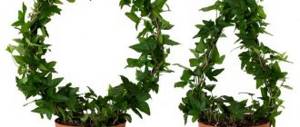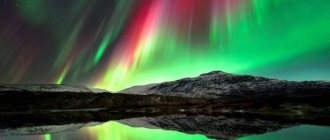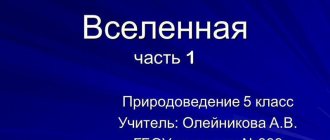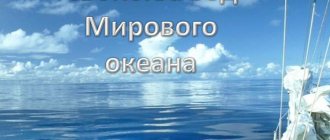- Reports and messages
- Geography
- Volcanoes and earthquakes
Our Earth has always been hot inside.
Many of its elements, such as gases and rocks, sought to rise and reach the surface. The most striking manifestation of the fact that there is life underground are volcanoes and earthquakes. This is a real manifestation of the movement that occurs between lithospheric plates. Earthquakes and volcanic eruptions are very difficult to predict; most often people are not prepared for such a turn of events. Sometimes such disasters become great tragedies for humanity. Almost all volcanoes are located on the edges of platforms; some may be active, while others may be extinct forever. Every volcano has a crater and a crater, at the bottom of which molten rocks and gases accumulate. Once the clusters gather in large numbers, they break through the crater plug and are thrown out. Stones, ash and lava begin to fly out onto the surface of the earth with great force, destroying everything that comes along the way. It is believed that if a volcano wakes up rarely, its eruption will be strong and dangerous. Lava can pour out of a volcano, both through the crater and through small cracks formed near it. Most often, volcanic eruptions and earthquakes occur where the junction between lithospheric plates is located. It will be very difficult for the cities and surrounding areas that are located in such an unfortunate zone. People have learned to observe the power of earthquakes. This work is performed by seismologists, who first of all warn the population about strong tremors. The saddest thing is that disaster is often difficult to predict. Tremors destroy houses, destroy gas pipelines, and the volcano forever plunges the area under piles of ash and lava. Tremors can also occur underwater. From such tremors, tsunamis arise, which with furious force throw waves onto the shore, destroying everything in their path.
Like seismologists, volcanologists perform important work. They monitor the activity of volcanoes and the scale of their disaster. They have a great responsibility to determine the strength of the eruption in time and give the signal to evacuate from the danger zone. Indeed, even today cities have been built at the foot of volcanoes, many people have established farms and vineyards there. This is because the land near the volcano is saturated with useful substances and minerals. Even in our time, many settlements are destroyed by the force of a volcanic eruption. As for tremors, we don’t feel half of them. They can only be noticed using a special device. But every year, several earthquakes take many lives, destroying everything that people have so carefully created.
It turns out that an earthquake sometimes becomes worse than a volcanic eruption, since it happens more often. Earthquakes, like volcanic eruptions, always occur suddenly; it is impossible to accurately calculate this process in advance. It’s as if they have their own life, which does not fit into a person’s life. Although people try to predict these situations, they always fail to do so accurately. Many turn out to be unprepared, because it is very difficult to look danger in the eyes. At the same time, earthquakes form cracks and change the relief. After this, new depressions and hills may form on the surface, and this is a considerable discomfort in human life, and probably in the life of nature itself.
Report on the topic 5th grade geography
Popular message topics
- Indoor rose
The rose can rightfully be called the most beautiful and beloved flower of man. Indeed, there is no more delightful and elegant plant on our planet. A flower belonging to the rosehip genus of the rose family, - Personal hygiene
Man is by nature a cultural creature, and in order to maintain this culture in society, everyone is required to observe the rules of behavior and personal hygiene. This knowledge is passed on from mother to child. This is the most important thing to support - Orchids
Orchids are amazing plants that can be grown anywhere in the world. Difficulties can only arise in northern countries. At the moment, the plants are widespread in the tropics. Orchids easily adapt to new
Project and presentation for primary classes “Volcanoes”
Relevance: while listening to the news on TV, I heard that Mount Etna began to erupt in Italy, Sicily. He has been sleeping for the last four months. Now streams of lava are flowing along the slopes of the fire-breathing mountain, and clouds of smoke are escaping from the crater.
I set out to find out how and under what conditions volcanoes erupt. Make a model of a volcano.
Hypothesis – there are many active volcanoes and they all pose a danger to people
Study
volcanoes on Earth that can become active at any time. They form when molten rock, called magma, rises to the surface of the earth and breaks through thin layers. Magma flows can remain underground for hundreds of years and then suddenly burst to the surface.
The ancient Romans believed that the god of fire, Vulcan, lived deep underground. When he gets angry, cracks form on the surface of the Earth, from which flames, smoke and molten fiery mass burst out, and the space around is covered with ash and stones.
Modern science finds another explanation for this natural phenomenon, but the name “ volcano ” itself has been preserved.
The volcano is a mountain with a very deep hole at its top, resembling a funnel in shape. This crater is called a crater. Through a hole from the depths of the Earth, a molten mass of rocks - lava - pours out onto its surface.
Its temperature is about 1100 degrees (even steel melts at this temperature). When a volcano erupts, more ash and smoke, or as volcanic gases are also called, burst out to the surface.
The volcano has a hole - a vent from which hot gases, molten stones and ash can burst out. Sometimes they flow out of a volcano, and sometimes they fly into the sky as if by an explosion. Such an explosion is called an eruption.
Lava, rock fragments, and volcanic ash form a cone around the hole. Therefore, as a result of an eruption, mountains can form on land and islands in the ocean.
There are three types of volcanoes, the names of which speak for themselves - active, dormant and extinct.
A volcano is active when huge plates of the earth's crust collide or, conversely, move apart.
Volcanic ash scatters over several kilometers and forms a layer that can cover the surface of the earth from 2 meters to several thousand kilometers.
A volcanic eruption usually begins suddenly, and people do not always have time to escape. The lava flow and rock fragments sweep away everything in its path and claim thousands of human lives.
Another type of eruption is slow, when hot lava flows down the slopes of the volcano, burning everything in its path, but the population has time to leave the dangerous area. Such is Mount Etna, which has been erupting from time to time for 2,500 years.
A volcanic eruption can cause enormous destruction. Thus, the Roman city of Pompeii was completely destroyed and buried under a layer of lava and ash during the eruption of Mount Vesuvius, which occurred in 79 BC. uh
The ruins of the city of Pompeii, which died in 79 during the eruption of Mount Vesuvius. The city is perfectly preserved thanks to a thick layer of volcanic ash.
In our country, on the Kamchatka Peninsula, there are also volcanoes. The volcanoes of Kamchatka are a World Natural Heritage of Russia. The Klyuchevskaya Sopka volcano, whose height is 4759 m, erupts every 6 - 7 years, the eruption continues for several months. There are a total of 28 volcanoes on the peninsula.
Currently, scientists have developed many methods for predicting eruptions, including identifying “hot spots” using satellites.
Conclusion: a volcanic eruption is dangerous, but at the same time it is a fascinating spectacle that you really want to see.
Research work with presentation “Volcanoes in nature”
Natalya Alieva
Research work with presentation “Volcanoes in nature”
Dozens of volcanoes erupt on Earth every year. Some of them reach catastrophic proportions, bringing untold disasters to people.
This unique and formidable natural phenomenon was incomprehensible to man in the past and gave rise to fear and various superstitions. Nowadays, the scientific and practical study of volcanoes makes it possible to find out the composition of the deep layers of the Earth and use lava, hot water, and steam for human benefit. But even now scientists cannot predict the onset of volcanic eruptions.
Manifestations of volcanism are one of the most characteristic and important geological processes that are of great importance in the history of the development and formation of the earth's crust. Not a single area on Earth - be it a continent or an oceanic trench, a folded area or a platform - was formed without the participation of volcanism.
Volcanoes are fraught with secrets. And everything unknown has always attracted humanity.
Current relevance
My job is to conduct experimentally a volcanic eruption. As part of this work, I will make the following conclusion about how a volcano during an eruption affects the nature of the Earth and humans in general.
Target
My work is to study the factors that lead to volcanic eruptions in nature.
To achieve this goal, it is necessary to solve the following tasks
:
• get acquainted with the literature on the topic of work;
• get acquainted with the structure of volcanoes and their types;
• study the causes of a volcanic eruption experimentally.
Before proceeding with the experiment, I propose to consider the characteristic features of the structure of the volcano.
What is a volcano and its structure
Volcanoes are cone-shaped or dome-shaped elevations above channels, explosion tubes and cracks in the earth’s crust, through which gaseous products, lava, ash, and rock fragments erupt from the depths. Manifestations of volcanism are one of the most characteristic and important geological processes that are of great importance in the history of the development and formation of the earth's crust.
The word "volcano" comes from the name of the ancient Roman god of fire, Vulcan.
Let's look at what a volcano is made of:
MAGMA CHAMBER
(molten fiery liquid mass of predominantly silicate composition) - occurs in the earth’s crust or upper mantle.
VOLCANO MOUTH
- a channel through which magma rises to the crater (formation of volcanic islands).
LAVA
- a hot liquid or very viscous, predominantly silicate mass that pours onto the surface of the Earth during volcanic eruptions.
CRATER
- a depression in the form of a bowl or funnel formed on the top or slope of a volcano as a result of its active activity. The diameter of the crater can be from tens of meters to several kilometers, the depth - from tens to several hundred meters.
VOLCANIC ASH
is a product of crushing and spraying of liquid or solid lavas by volcanic explosions. Consists of dust and sand particles with a diameter of up to 2 mm.
Creating a volcano model at home
During a volcanic eruption, clouds of ash are thrown into the air, and lava flows along the slopes. This is a very exciting sight; watching it in close proximity is life-threatening. But you can make a volcano at home and conduct experiments every day, admiring the eruption without a threat to life and health.
First, let's make the volcano itself. For this I needed the following materials and items: a small plastic cup, newspapers, a candy box, putty, water.
I glued crumpled newspapers to the box, then diluted the putty with water to the consistency of thick sour cream. I formed a relief from newspapers: mountains, slopes, depressions, a river, and coated it all with diluted putty. When the model was dry, I painted it with gouache.
Conducting the experiment
I will conduct the “Erupting Volcano” experiment on a model at home.
To conduct the experiment, I will need: a model of a volcano and materials for the experiment: water, red paint to color the lava, two teaspoons of baking soda, a few drops of dishwashing detergent, 20-30 ml of table vinegar 3-9%.
PROGRESS
:
Pour two teaspoons of baking soda and a few drops of dishwashing detergent into the hole of the volcano. In a plastic cup, stir a little red paint with water until an intense color forms. This will make the "lava" look more realistic. Pour 2 tablespoons of table vinegar into the colored water and mix everything. Carefully pour the resulting solution into the crater of the volcano.
Pouring solution into a volcano crater
Research result.
When vinegar and baking soda are mixed, a chemical reaction occurs, releasing carbon dioxide, which bubbles out of the volcano, causing the mixture to overflow the crater. Everything is completely harmless and safe: NaHCO3 (sodium bicarbonate, or soda) + HC2H3O2 (acetic acid) = NaC2H3O2 (sodium acetate) + CO2 (carbon dioxide) + H2O (water). Dish soap will make the “lava” bubble more.
Conclusion.
After conducting this experiment, I saw a volcano erupt. This means that I was able to independently create a natural phenomenon - a volcanic eruption.
What is a volcano
A volcano is a geological formation located on the surface of the entire earth’s crust, where hot magma has come to the surface, forming liquid hot lava, as well as pyroclastic flows, volcanic gases and stones - the so-called volcanic bombs.
Classification of volcanoes
Scientists classify volcanoes by their shape, they are: shield, cinder cones, dome and stratovolcanoes. In addition, volcanoes vary depending on the degree of their activity: dormant, dormant, extinct and active, as well as by their location: underwater, terrestrial, subglacial and some others.
Scientists consider an active volcano to be one that erupted in a long historical period of that time or in the Holocene, that is, a glaciation dating back to the Quaternary period, which has lasted for the last 12,000 years until the present. However, the concept of an “active” volcano is quite inaccurate, since the volcano itself, which has active fumaroles, is classified by some scientists as extinct, and by some scientists as active. Dormant volcanoes are considered to be currently inactive volcanoes, on which small eruptions are still possible, and extinct volcanoes are considered to be those volcanoes on which eruptions are unlikely. Along with this, among scientific volcanologists there is still no concrete concept of how to determine an active volcano, since the period of activity of a volcano can last from several months and even up to several million years. It is noteworthy that many volcanoes were active 10,000 years ago, however, in our time they are not considered active.
Summary of a game lesson on ecology with a presentation in the preparatory group of a kindergarten
Summary of the game lesson “Wonders of Nature” in the preparatory group
Author: Natalia Nikolaevna Shcheneva, teacher of MBDOU “Kindergarten No. 44 “Snow White”, Tambov Description of the material: I offer a summary of the game lesson for children of the preparatory group (6-7 years old) on the topic “ Wonders of nature".
This material will be useful for educators for conducting classes dedicated to the year of ecology. The outline of the game lesson is aimed at developing cognitive activity and curiosity in older preschoolers. Summary of the game lesson “Wonders of Nature” in the preparatory group
Integration of educational areas: “Speech development”, “Social and communicative development”, “Physical development”, “Artistic and aesthetic development”. Goal: formation of environmental knowledge, moral and value attitude towards nature. Objectives: educational:
expand children’s ideas about the nature of their native country;
developmental:
develop cognitive activity, curiosity, coherent speech, imagination, and play skills of children;
educational:
to cultivate a caring attitude towards nature and environmental conservation.
Equipment: map, route sheet, game paraphernalia (cameras, binoculars, backpacks), presentation, video about the northern lights, bath, flashlight, mirror, sheet of white paper, volcano model, mixture (soda-2 tbsp, citric acid-2 tbsp. .l., red gouache - 1 tsp, liquid soap - 1 tbsp, water - 150 ml.), lotus flower blanks. Methodological techniques: game situation, conversation - dialogue, looking at presentation slides and talking about them, experiment, productive activity of children, analysis, summing up. Progress: Educator: Guys, do you like to travel? (children's answers)
.
We received a letter from scientists. They invite the most daring and daring guys to take part in the expedition, where many secrets and miracles await. For this purpose, an “airplane” with the necessary equipment has been prepared (game paraphernalia: backpack, goggles, camera, binoculars or telescope)
.
Where do you think we can go? (children's answers)
.
Educator: That's right, we will go to the natural world. Nature keeps many secrets and wonders. Today we will try to solve some of them. Before going on an expedition, let's look at the route; a route sheet will help us with this. (Children trace the expedition route on the map)
.
What do we see? (children's answers)
.
We have to visit stations and complete tasks. You are ready? Is the crew ready to fly? (children's answers)
.
Then let's hurry up and hit the road. In order not to miss anything interesting, look through binoculars and telescopes more often, and take photographs. (Music plays, children go on an expedition). Station N 1 (slide: riddle, picture of a rainbow)
In the blue sky From edge to edge A bright colored path hung...
(Rainbow) Educator: That's right, it's a rainbow. An amazing phenomenon in nature. We all know the colors of the rainbow. Name them (children's answers)
.
What poem helps us remember the colors of the rainbow? (Every hunter wants to know where the pheasant sits)
.
A rainbow is an optical phenomenon associated with the refraction of light rays by numerous raindrops. Educator: Let's try to unravel the mystery of the appearance of the rainbow. Let's conduct the "Rainbow from Water" experiment. To do this, we need a bath of water, a flashlight, a mirror, and a sheet of white paper. Procedure of the experiment: a mirror is placed at the bottom of the container.
The flashlight shines on the mirror. The light from it must be caught on paper. A rainbow will be visible on the paper .
Station N 2 (slide: riddle, picture of the Northern Lights)
How beautiful the poles are, The skies sparkle there!
A bright flash here and there, but it’s not fireworks. (Aurora) Educator: Correct. This natural phenomenon is extremely beautiful. It is called the northern or polar lights. It is observed in Antarctica, in the north of our country. When the northern sky is illuminated by moonlight on frosty, clear nights, it turns into different bright colors and becomes as light as day. How does this happen? Our Earth with its north and south poles is like a huge magnet. When the solar wind blows across the Earth, it creates friction between the wind and the Earth's atmosphere. Solar particles collect in the layers of the atmosphere near the poles. This is how the aurora appears. An interesting fact is that it can sing. These sounds are inaudible to the human ear. You need special instruments to hear the singing of the northern lights. The aurora can only be seen at night. Watch a video about the Northern Lights Station N 3 (slide: riddle, picture of a volcano in Kamchatka)
There is a dangerous mountain, It might suddenly come to life.
He can breathe smoke, breathe fire, and can spew out magma. People in the world of different countries Know that she is... (Vulcan) Presentation. Experiment “Volcanic eruption” Equipment: model of a volcano, mixture for an eruption (soda-2 tbsp, citric acid-2 tbsp, red gouache-1 tsp, liquid soap-1 tbsp, water-150ml. ) Station N 4 (slide: riddle, picture of a lotus from the Astrakhan region)
A bud sticks out of the water, sways in the wind.
When the sun warms up, it immediately blooms! (Lotus) Educator: Lotus is a miracle of the Astrakhan region. It is also called the Caspian rose. July-August is a spectacular sight for tourists who visit the lotus fields. The lotus pleases with its flowering for two months, then the capsules remain - the receptacle, in which the lotus nuts ripen. In autumn, under the influence of the wind, the egg capsules break and nuts spill out of them. These nuts are an excellent food for birds, especially geese. This exotic plant can be seen in the Astrakhan and Volgograd regions, Krasnodar Territory, and the Far East. The lotus is listed in the Red Book; it cannot be picked and there is no point in picking it, since the petals of a picked flower quickly fall off. Productive activity “Lotus Flowers”. Lotus flowers made by children have their petals curled toward the center using a pencil. Then the children lower the lotuses onto the water poured into the container. Educator: Guys, what's going on with the flowers? (children's answers)
The flower petals begin to bloom
(the paper gets wet, becomes heavier, and the petals open). Educator: Our expedition has come to an end (Having taken their seats on the “plane”, the travelers return home.)
Did you enjoy traveling?
(children's answers). Educator: What did you like most? What new did you learn? (children's answers).
Don't destroy nature's house, boys and girls!
Otherwise, these miracles will remain only in books. After the lesson, you can organize an exhibition of photographs (children’s drawings) on the topic “What we saw on the expedition,” and invite parents to write down their children’s stories about what they saw on the trip.
Presentation on the topic: Wonders of nature
We recommend watching:
An environmental lesson for children in the preparatory group of a preschool educational institution. Scenario for an environmental holiday in kindergarten. Senior preparatory group Ecological game for the preparatory group Encyclopedia - one of the forms of introducing preschoolers to the natural world of their native land
Similar articles:
Lesson summary on the topic “The Red Book” in the preparatory group
Educational and entertaining event on ecology for the preparatory group. Abstract
Summary of a lesson on ecology in the preparatory group. What does ecology study?
Summary of a lesson on ecology in the preparatory group. Theme: Water
Summary of a lesson on ecology in the preparatory group. Topic: Soil








